"Someone tell me if there is a better way of doing this" - yes, shift d, then RMB.
then G(rab) + Z(lock to Zaxis)
Thanks, also shift-d then Esc does the same (duplicating an object without any translation transform)
You guys are hilarious :) like Autodesk community, just clap for nonsense things :))
Don't remember that you want to implement OpenBIM/BIM not be "3D modelers" who do workflows "MANUALLY"
I checked the video, it's still preliminary, and mostly "manual" than "automated"
@ReD_CoDE said:
You guys are hilarious :) like Autodesk community, just clap for nonsense things :))
Don't remember that you want to implement OpenBIM/BIM not be "3D modelers" who do workflows "MANUALLY"
I checked the video, it's still preliminary, and mostly "manual" than "automated"
I respectfully disagree. I checked the video and for about an hour looked at the code. There is a LOT of smart automation here and a great combination of manual modelling of a conceptual model followed by an automatic conversion into a very impressive IFC model. Plus there is some interesting topological derivation to find exterior vs. Interior surfaces and derivation of Cells. I know because we had to write similar code.
@topologic It's somewhat good, but just in a small area of a generative/evolutionary approach
I don't see many other things like "subdivision strategy", a well defined "growth strategy", ...
@ReD_CoDE said:
@topologic It's somewhat good, but just in a small area of a generative/evolutionary approach
I don't see many other things like "subdivision strategy", a well defined "growth strategy", ...
Yes these would be quite interesting areas to pursue. It is open source so the community can add to it anything they see is missing.
Personally I'm interested both you share the workflow your solutions follow?
Does it have "data storage?"
How does its selection work? 1st Generation? 2nd Generation? ..., Fitness Function? Which kinds of Parents? Which Children? ...
Breeding?
Generation?
Evaluation?
...
Other techniques?
The work of @brunopostle is amazing.
IMHO the strong potential here, as @topologic already insinuated, is on the conversion of the model into actual topologically defined entities and once done that, the translation to IFC entities should be trivial (though awfully hard) .
I'm working on the conceptual side of this line of work and this practical applications are a huge GO, GO, GO!
I really want to help, but if you share the workflows and techniques you use, not presenting 3D models
However, about topology and geometry parts, I think non-manifolds are good choices, however, still, there are some considerations about non-manifolds, but most of the geometric kernels support or somewhat support them
@ReD_CoDE said:
I really want to help, but if you share the workflows and techniques you use, not presenting 3D models
However, about topology and geometry parts, I think non-manifolds are good choices, however, still, there are some considerations about non-manifolds, but most of the geometric kernels support or somewhat support them
For topologic everything is on github. Documentation and sample workflows are on https://topologic.app website. The following video might be helpful to explain the basics of Topologic
"But wait there's more!"
By default the topologist script assumes all the cells are 'living room', but now I created a set of widgets that you can drop into the cells to indicate what kind of room they are:
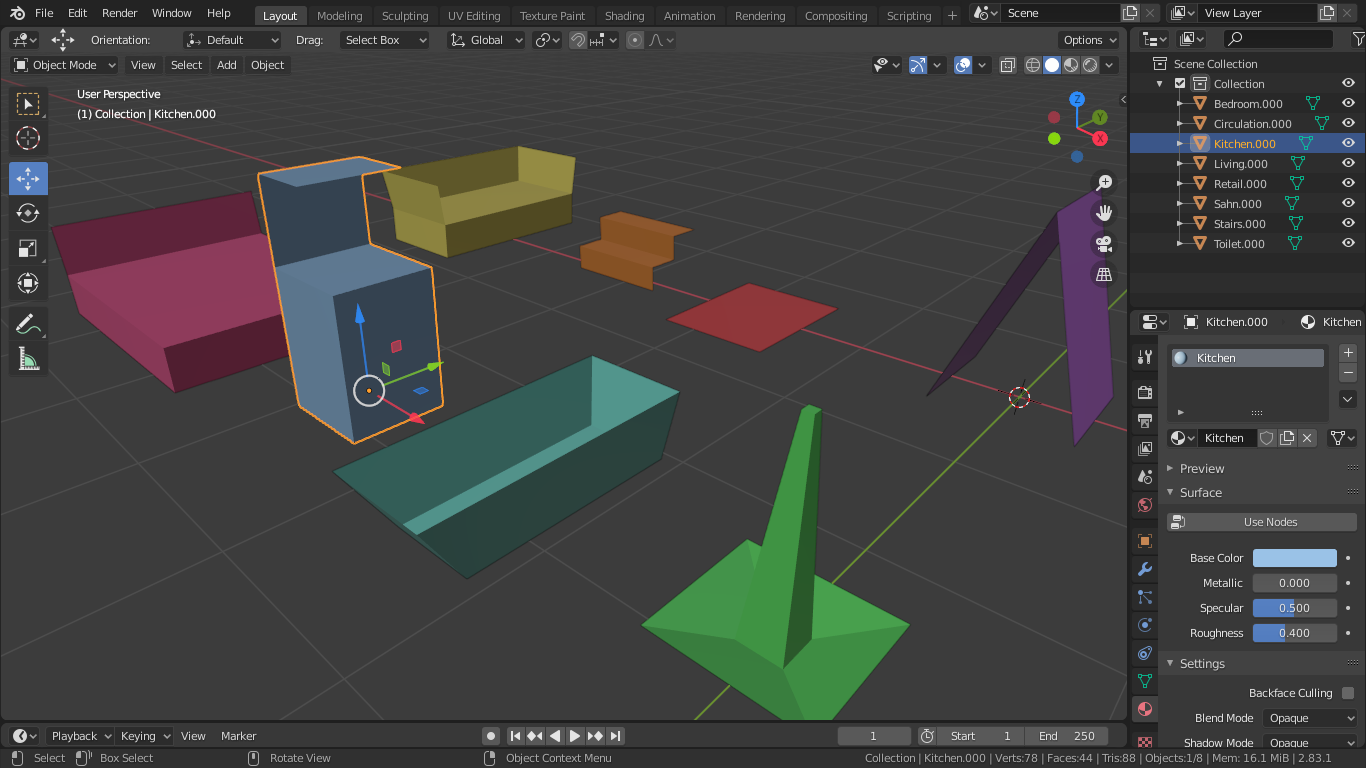
Amongst other things, this controls where doors are placed, and what kind of doors and windows to use. The circulation graph gets pruned to only show links where there are doors and stairs (note this particular image shows that this building doesn't have a viable circulation graph, there are several unconnected zones - you can blame the architect):
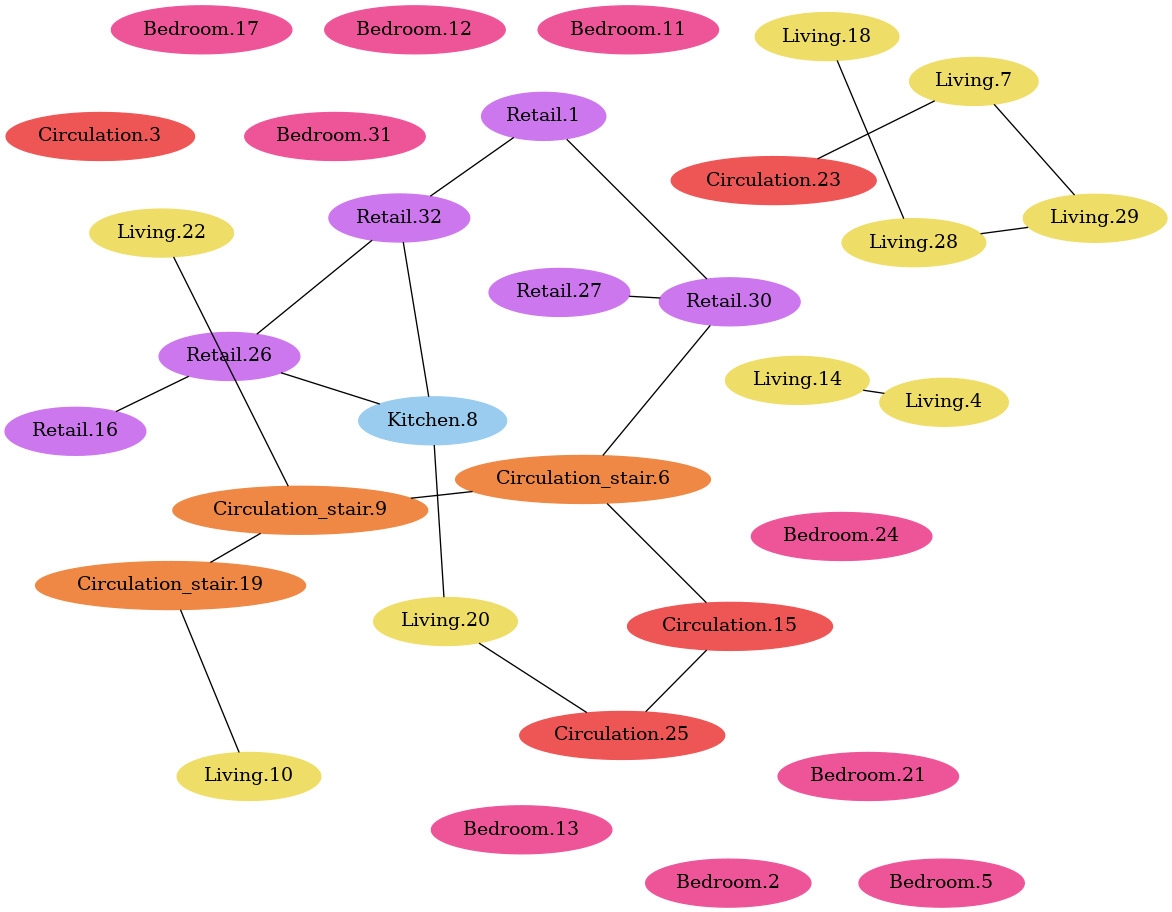
It draws stairs (sort-of, this is a bit broken for now as it doesn't account for the exact location of doors):
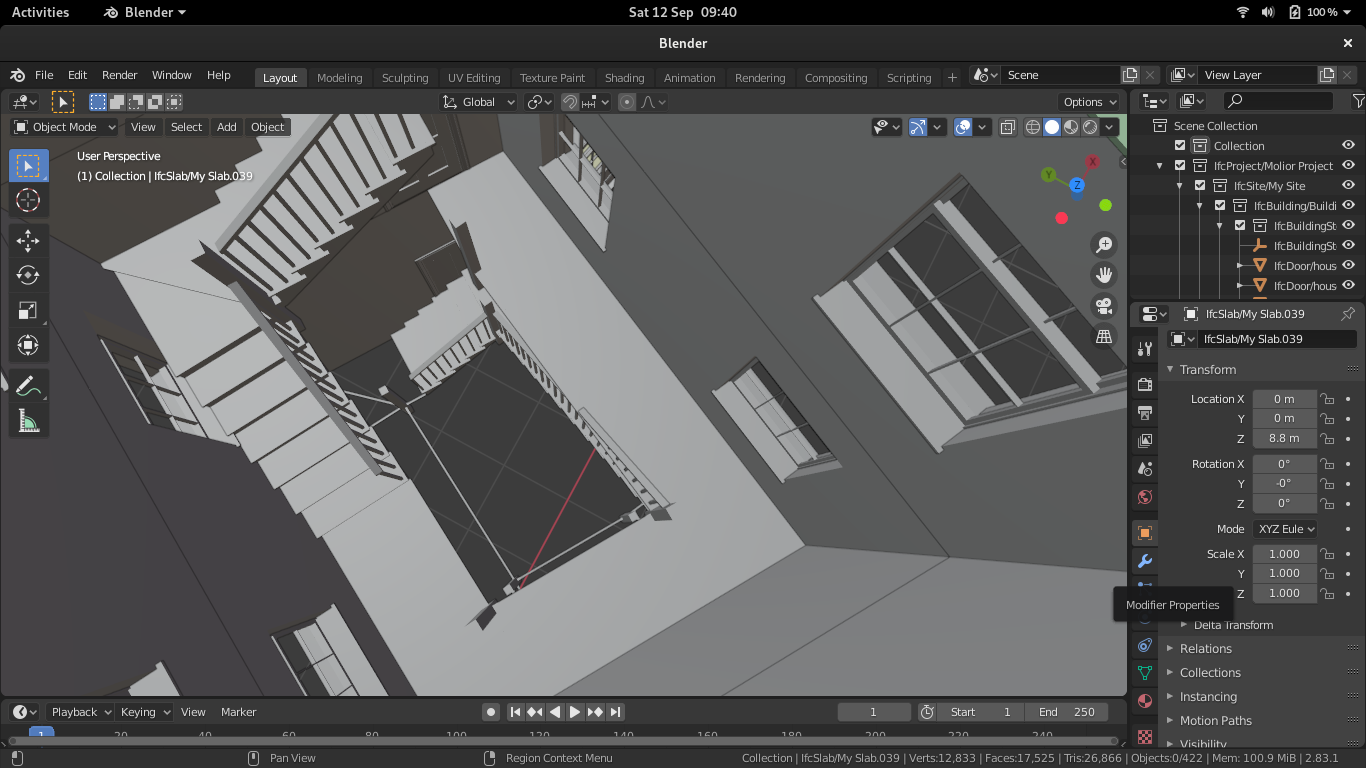
Doors varied by room 'type':
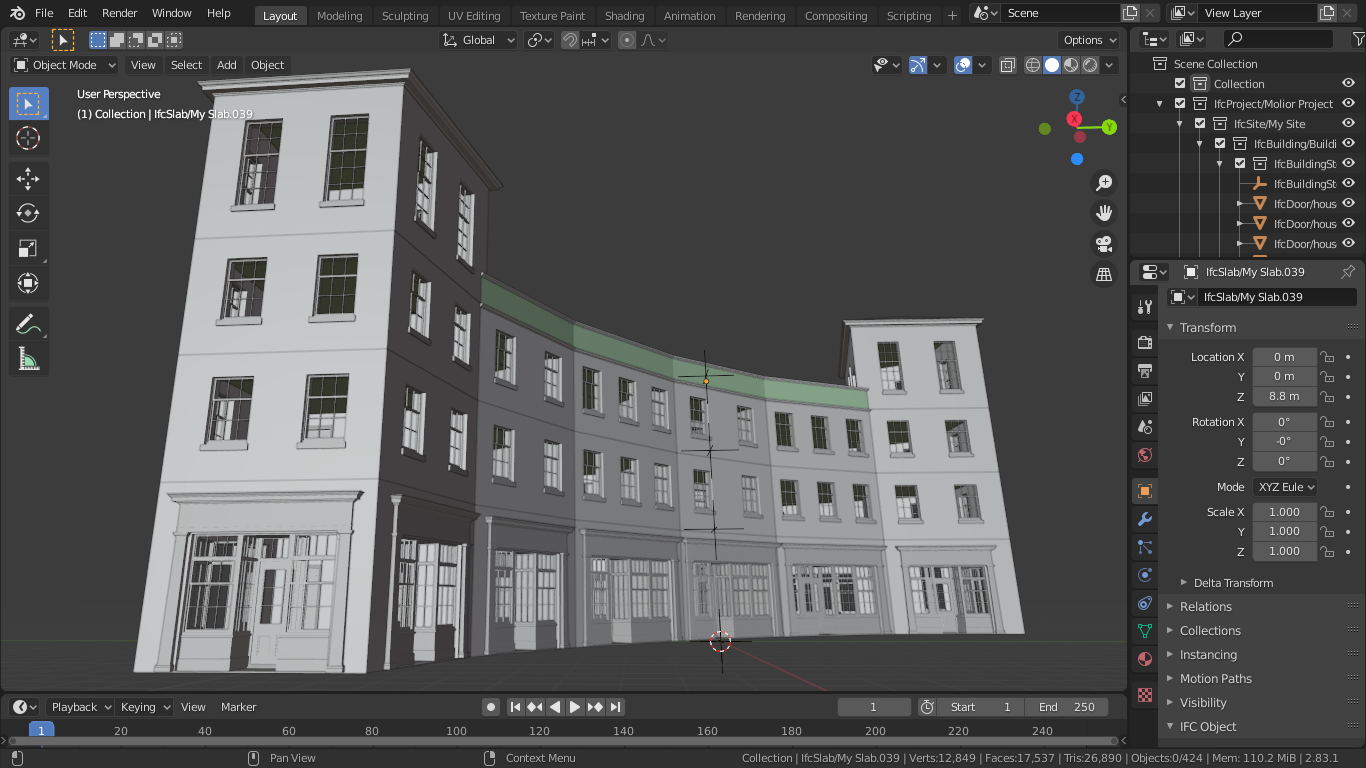
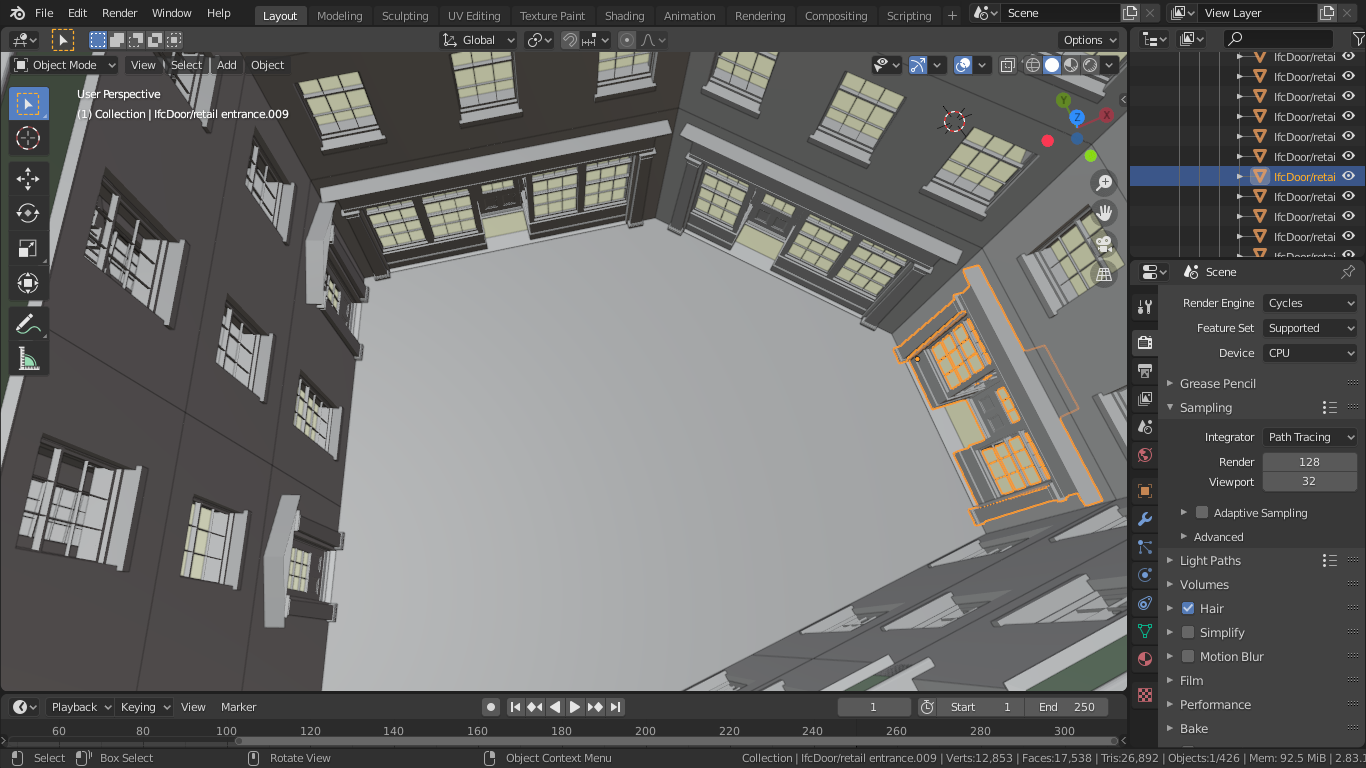
This is still a proof of concept, ultimately this whole thing wants to be an interactive tool where the IFC result is updated in place, that doesn't involve exporting and importing geometry. So all cells would automatically gain a widget where you can set parameters, or view suggestions or information about the room.
@brunopostle Very cool. I just wish you were able to try Topologic in this environment. It has all you are trying to do built-in including room content, dictionaries to store not only space types but all sorts of other information. You would not have to invent bespoke functionality and you would not need file export/import. We are looking at Topologic->IFC. Maybe in a couple of months we can have an initial implementation. Any advice on how to deal with IFC would be much appreciated.
@topologic I looked at writing a SWIG wrapper for Topologic, as this would potentially generate both a Perl and Python API, but this is beyond my C++ capabilities.
IfcOpenShell seems like a very capable library, though presumably you would want to create the actual geometry in a node editor like grasshopper/dynamo/sverchok.
@topologic I can also offer some advice on supporting IFC. @brunopostle has his own Perl-based IFC library, which is one option, and FreeCAD, BIMServer, and the BlenderBIM Add-on use the C++ / Python binded IfcOpenShell library. There is also XBim, which is .NET based, but perhaps if you want to have easier / out-of-the-box cross platform support considering the portability issues with Topologic, it might be a good idea to stick to IfcOpenShell.
Do you think topologic could work with sorcar or sverchock for blender?
@JQL at risk of answering out of turn, I would say yes. Remember that Sorcar and Sverchok is just a particular UI approach to programming (a very powerful and complex one, to be sure, but scoped to UI) - so as a general statement Sorcar, Sverchok, or DynamoBIM, etc, can all be plugged into practically any other system.
@JQL said:
Do you think topologic could work with sorcar or sverchock for blender?
I think this would be doable, but you need the Python API for Topologic. Has anybody tried generating IFC metadata in Sverchok output? Or would there need to be some blenderbim integration?
For the record, @mostapha and I are meeting up soon on integrating Ladybug with Blender, and I've been putting together more util functions for querying the schema itself. Put these together, and I suspect we could quite easily generate a set of IFC Sverchok nodes, similar to how GeometryGym's IFC system works.
@brunopostle said:
... presumably you would want to create the actual geometry in a node editor like grasshopper/dynamo/sverchok.
Topologic can readily read in OCCT BREP so FreeCAD can be used as the editor and then we can simply adapt “Topology.ByImportedBREP” and “Topology.ExportToBREP” to move geometry back and forth. For Blender we would have to rewrite Topology.ByGeometry and Topology.Geometry. We have the templates for Dynamo and Grasshopper/Rhino and we support complex geometry so should be straightforward, but a bit time consuming. Easier if we just support flat-faced polyhedra.
I've been investigating OSArch resources lately and trying to understand a lot that I never dealt with before. So I will keep on asking basic and sometimes stupid stuff if you don't mind:
What is topologic used for exactly?
For geometry generation? Based on which principles?
For querying geometry generated by other software? How do those queries get inserted into final output? Schedules? Drawing labels?
To run engineering analysis? Do we have to create our own calculation methods or are the methods included? Is the graphical output automatically generated?
I'm honestly mostly interested in the conceptual and query part of the equation as my architectural practice still is very independent from the engineers I collaborate with and most of them are not very far from this kind of processes.
personally I'm a fan of AGPL3 and GPL3, but I don't know Sverchok with its GPL3 license is suitable for Ladybug or not?
It's up to Mostapha and his friends
However, I saw some performance issues on Sverchok and if someday want to develop my solution on Blender, my choice would be Animation Nodes
@JQL Please be patient with me as I explain the story behind topologic. Topologic was the result of a three year £300,000 grant from the Leverhulme Trust. The project was lead by me (Wassim Jabi) at Cardiff University and Robert Aish (UCL). The main proposal was to conceptualise, model and analyse buildings in a more useful and richer manner. To do that we needed a better representation for buildings and especially the spaces in a building. But also their relationships and adjacencies. We settled on non-manifold topology as the best way to represent the conceptual model. We can then use that model to ask useful questions in any stage of the design, but mainly in the early stages. Let me list some simple examples/questions that topologic is good at answering:
-
What is the surface area of the internal (or external) walls of my building?
-
Wall A: what are the rooms that use you as a boundary? If one of them is a radio studio, please put on yourself some extra sound insulation.
-
What is the glazing ratio on this building and what is the average cooling loaf?
-
I am deciding where to put the water cooler: what space is the most central in this building?
-
How long will it take me to reach the nearest fire exit from the furthest and most isolated office?
-
Which of these 20,000 configurations has the most efficient circulation path?
-
What node design should I use for a particular junction
-
How can I optimise the HVAC system?
-
Which rooms in my hotel have the best views?
-
How many desks can I place to maintain the 2m 6ft rules?
If everyone in the open office plan gets up to go to the conference room, will they run into each other?
So if some of these examples intrigue you, then topologic can be of help.
I think both Topologic and Bruno's project are invaluable and have developed based on two different goals
Topologic with a focus on topology and non-manifolds, and to answer some needs in the industry
And Bruno's project with the goal of investigating pattern language and be "SOMEWHAT" procedural
@topologic said:
So if some of these examples intrigue you, then topologic can be of help.
Stating it that way, looks simple. I guess every question is of interest to me. I also guess that's the kind of questions we use our intuition, intelligence, experience and hardwork to answer when we design.
The thing is that answering them through topologic isn't about pressing a button is it?
What skills and software do I need to have to work with that? Do you see a small studio using it? Do you think you need a dedicated programmer to work with it? Or do you think a general architect can deal with it? Can it be used as complementary to other modelling tool's or should you have a specific workflow made for it for it to work?
Sorry for insisting...